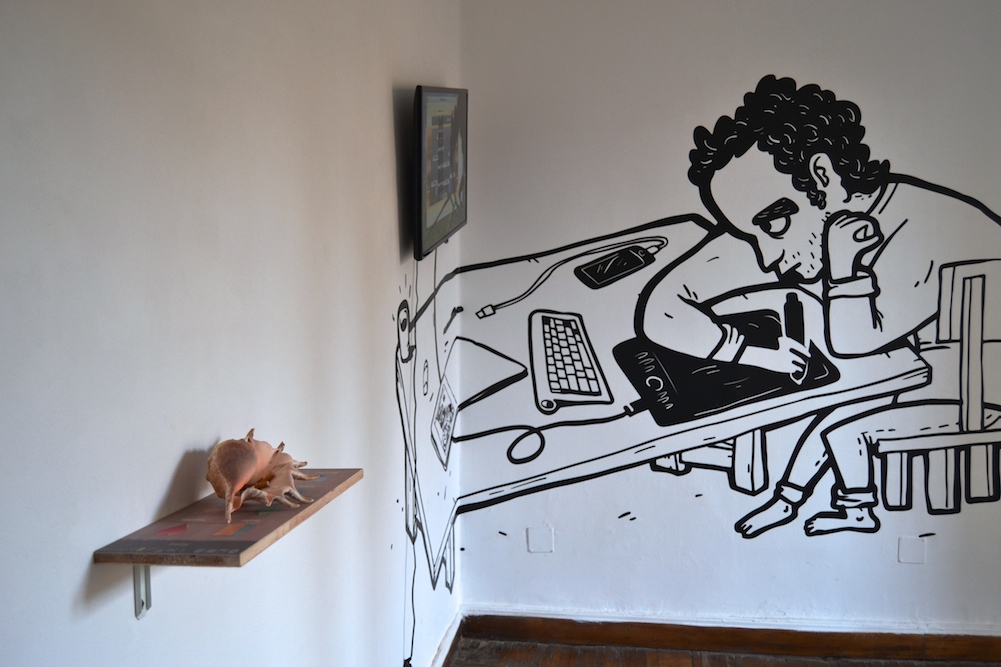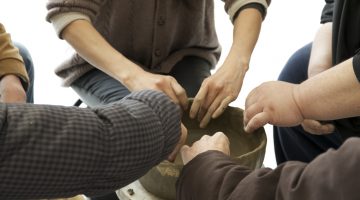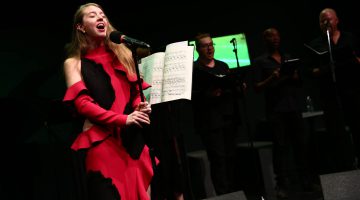Artists Taha Belal and Jenifer Evans operate Nile Sunset Annex, a self-funded apartment gallery in the Garden City neighborhood of Cairo, Egypt. The duo releases a publication with each regular exhibition and have begun their own public collection, obtaining one work from each show. They traveled to San Francisco in July 2015 to open Nile Sunset Annex: The Many Hats at Haines Gallery. True to name, the exhibition featured 1:5 replicas of works in their collection, documentation of past shows, works made by both artists, and a comprehensive collection of Egyptian contemporary art ephemera.
The artists answered questions collaboratively, via e-mail, from their residency at lugar a dudas in Columbia. A self-produced catalog to the “Many Hats” exhibition and retrospective of their project as a whole, “Nile Sunset Annex: Thanks to the Artists,” is available at Haines Gallery.
Evan Reiser: You describe, in the foreword to your publication, how “conflicting intuitions, sensibilities, dreams and fears around visual art” led to your collaboration. Can you speak more to the initial motivation to begin Nile Sunset Annex?
Nile Sunset Annex: We wanted to take things into our own hands, become more excited about making and looking at art in Egypt, create a platform that would allow us to get properly involved in a conversation about art there, and perhaps experiment with showing other people’s art when we weren’t totally sure what art we wanted to make and show ourselves in that context. Maybe there was also a less conscious desire to gain some cultural capital for ourselves….
More specifically, we were reacting to the art context in Cairo, where more often than not we were underwhelmed by the exhibitions we saw, and following our own personal preferences in terms of art. We thought that, for various reasons (funding, education, lack of an art market, historical and environmental factors), artworks prioritizing formal aspects were under-represented, in favor of socio-politically themed and narrative-based works and an over-emphasis on digital photography and video. And in general existing institutions held exhibitions fairly infrequently.
Taha was living with Hady Aboukamar (who cofounded Nile Sunset Annex with us but moved abroad in 2014) in a flat with a spare room, and Jenifer and Hady had recently done a collaborative exhibition on the roof above the apartment. One day we met in Hady’s studio and agreed to try and run a space in the spare room. We thought about the kind of art we would want to see, and how we wanted to show it. Having regular exhibitions and trying to install them as well as possible on a technical level was important to us.
We agreed that the exhibitions would be funded jointly by ourselves and the exhibiting artist(s), to avoid wasting time on applications and reports and the inevitable strings attached to funding. We agreed to present solo shows, which we thought there was a lack of, and to do regular one-month exhibitions that emphasized the formal and the physical.

Overview of “Museumish,” an exhibition of works by Mariam Elias, Sobhy Guirguis and Paradoxia, with a Nile Sunset Annex copy of a painting by Wadiaa Shenouda, 2014.
How would you describe your own art community in Cairo? Is there a student population? Are their residencies, which (temporarily) bring in international artists?
Cairo’s art communities are interesting. The way we see it, with a few overlapping exceptions (of artists and art spaces) there’s a division between the state-run art scene and some associated (often fairly stuffy) commercial galleries, and a scene funded by international cultural organizations and a fairly new commercial gallery called Gypsum. The latter is what Nile Sunset Annex is most closely connected to.
Overall, in this scene there are various well-established artists and curators in their late 30s or early 40s who mostly work abroad. There are many younger artists. Some live abroad, temporarily or permanently, but still exhibit occasionally in Cairo (five of the Egyptian artists we’ve shown live abroad). Quite a few non-Egyptians are part of this scene as well—curators, writers, artists. There are few serious art critics though, or collectors of contemporary art. In terms of our audience, we often have artists, film people and journalists, culture administrators, and artists’ friends.
The art schools that offer qualifications are state-run with decades-old curricula—while there are a lot of art students, many are not interested in contemporary art. There have been attempts at non-governmental art education, for example Medrar organizes workshops, the Contemporary Image Collective (CIC) runs a photography school, Wael Shawky initiated a program called MASS in Alexandria, and Beirut ran a program this past academic year.
Residencies and other projects bringing in international artists are generally also funded by international cultural organizations. Hosts include Townhouse, CIC, Artellewa and Medrar. And artists and curators from nearby countries like Jordan or Lebanon regularly come through Cairo, often due to personal connections.

Overview of “It’s Never Too Late to Talk about Love,” a solo exhibition at Nile Sunset Annex by Mahmoud Khaled, 2013.
Your July artist talk at Kadist in San Francisco, a hybrid of performance and lecture, focused much attention on the context of art objects in Egypt, both of works made by Egyptian artists and those of Western provenance. Did you feel differently about any of your works or projects as they were re-contextualized for the show at Haines?
In Cairo, Nile Sunset Annex has a clear role of helping create exhibition opportunities, although within very specific parameters. Doing things as Nile Sunset Annex outside of Egypt immediately puts us in a very different position. One risk we want to avoid (especially because we’re a very small-scale, idiosyncratic project) is being seen as spokespeople for Egypt’s art scene, or as offering a comprehensive view of it. We’re still trying to think through how our work will be interpreted by an audience unfamiliar with the context that we are working in.
While there is quite a lot of information in the Haines show—from the selection of posters from the archive of Egyptian art ephemera we’ve been compiling, to the whole catalogue of publications we’ve produced and the postcards we’ve made of each work in our collection—there are various elements that don’t give any information at all and that don’t really make sense.
So ideally the show can be seen as an artwork by the two of us that also represents a sort of overview of all our activities so far. It gave us the chance to think about how we could visualize our activities, even ephemeral things like the functioning bar we ran as an exhibition in 2013 and non-art-related things like the other jobs we have that help us fund Nile Sunset Annex. It allowed us to step back—like taking a photograph of the whole project—and most importantly, help us think about how we want to move forward.
The most time-consuming element of the show is our groupie-like handmade mini-approximations of the artworks in our collection, which are placed next to the postcards of the original works to create odd doubles. These reflect our interest in copies and fabrication, but due to the complications of getting artworks in or out of Egypt, and lack of funds, it’s also a practical way to bring a version of what we’re doing in Cairo to other places and audiences, and to get different reactions and learn more about what we’re doing.

Nile Sunset Annex. “An Artwork by Nile Sunset Annex,” 2015. Suitcase, cardboard, paint, 20.5 inches high. Photo courtesy Nile Sunset Annex/Haines Gallery.
I love the titles of your exhibitions! In particular, “What are you doing, object?” and “What are you doing, drawing?” Are you interested in artworks that are difficult to classify or make sense of? The titles don’t necessarily imply an anthropomorphic quality, but a mischievous one.
Thank you! Yes we’re really interested in those kinds of artworks, especially ones where you maybe do a double take and think “what is this?” or “is this art or something else?” We’ve also exhibited things that weren’t initially conceived of as art, like the budget of another art institution, some embroideries, some chairs, a bar… It’s an approach that we feel sort of counters the verbal certainty that officials and journalists and “experts” rely on.
Due to the prominent role of explanatory texts in many of art exhibitions in Egypt currently, we felt that viewers often go into exhibitions looking for a text to explain what they’re looking at or what they’re supposed to get out of it. We’ve used as little text as possible—our exhibition blurbs are a few sentences that are more descriptive than explanatory. We want viewers to look at artworks rather than worrying about “understanding” what they’re meant to be about.
“What are you doing, object?” was our first attempt at curating a show at a commercial space. We wrote: “Nile Sunset Annex is primarily interested in objects to which our meanings fail to stick. Many shapes, like experiences, cannot be properly described. Outside of categories and conceptualizations, despite our insistence, they are slippery and alien.”
We’re hoping to move away from a white-cube like space, which might help blur definitions a bit more.

Shelves representing previous Nile Sunset Annex exhibitions, each with mini-approximation, postcard and publication at Haines Gallery for Nile Sunset Annex: The Many Hats, 2015. Mixed media, dimensions variable. Photo courtesy Nile Sunset Annex/Haines Gallery.
Some friends here in SF with an apartment gallery recently had an uncomfortable interaction with their landlord, who threatened to disrupt the final show at the space when he discovered an artist installing their work. Do the locals and neighbors in Garden City view your project with any level of indifference, support, hostility, or curiosity? How is an apartment gallery perceived in Cairo versus how it might be perceived in other cities you’ve lived? (Note: Taha attended graduate school in San Francisco, Jenifer previously lived in the UK.)
Our neighbors have mostly seemed to view Nile Sunset Annex with indifference. We’ve been worried a few times that a particular exhibition (like the bar, for example) would attract the attention of neighbors or police. But no complaints so far, touch wood!
As far as we know we’re the only art space in Cairo inside a living space. Some visitors find it unusual at first but mostly our (small) audience has been super supportive. One benefit is that we have some interesting conversations sitting down with visitors over tea or a coffee or even lunch. We’ve had visitors that assume the show takes place in the whole apartment or who are surprised by how small the art space is. Occasionally visitors will come to see an exhibition without any prior notice so it’s a surprise.
Do you have any upcoming exhibitions, publications, or projects you’re particularly excited about?
We’re currently thinking about how we want to evolve, partly because after two and a half years it seems like a good time for a shake-up, partly because we have new concerns we want to explore, and partly because we felt we’d been spreading ourselves a bit thin lately. Our residency at lugar a dudas has been very inspiring and gave us space to think, and we sent a questionnaire to all the local artists we’ve worked with to try and figure out how we can improve.
We’re working on an exciting editorial project with a Brussels-based organization Mophradat, in which we choose art-related words in English and in Arabic that have a twist when translated between the two languages, and find, create or commission a text in each language to go with each word.
Perhaps the biggest challenge we’ve given ourselves is figuring out how to move away from the white cube and work with rather than against the environment of Cairo (characterized, we think, by dust, noise and fluidity) while still focusing on object-based artworks.

Overview of “New Folder 2,” a collaborative exhibition at Nile Sunset Annex by Kareem Lofty and Andeel, vinyl, video, printed shelf, shell, 2015.



